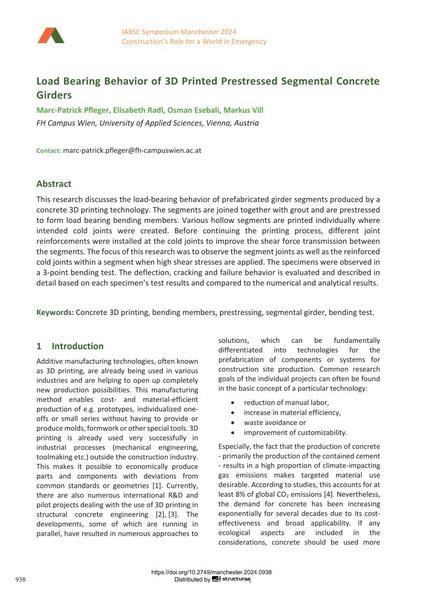Load Bearing Behavior of 3D Printed Prestressed Segmental Concrete Girders

|
|
|||||||||||
Détails bibliographiques
| Auteur(s): |
Marc-Patrick Pfleger
(FH Campus Wien, University of Applied Sciences, Vienna, Austria)
Elisabeth Radl (FH Campus Wien, University of Applied Sciences, Vienna, Austria) Osman Esebali (FH Campus Wien, University of Applied Sciences, Vienna, Austria) Markus Vill (FH Campus Wien, University of Applied Sciences, Vienna, Austria) |
||||
|---|---|---|---|---|---|
| Médium: | papier de conférence | ||||
| Langue(s): | anglais | ||||
| Conférence: | IABSE Symposium: Construction’s Role for a World in Emergency, Manchester, United Kingdom, 10-14 April 2024 | ||||
| Publié dans: | IABSE Symposium Manchester 2024 | ||||
|
|||||
| Page(s): | 938-946 | ||||
| Nombre total de pages (du PDF): | 9 | ||||
| DOI: | 10.2749/manchester.2024.0938 | ||||
| Abstrait: |
This research discusses the load-bearing behavior of prefabricated girder segments produced by a concrete 3D printing technology. The segments are joined together with grout and are prestressed to form load bearing bending members. Various hollow segments are printed individually where intended cold joints were created. Before continuing the printing process, different joint reinforcements were installed at the cold joints to improve the shear force transmission between the segments. The focus of this research was to observe the segment joints as well as the reinforced cold joints within a segment when high shear stresses are applied. The specimens were observed in a 3-point bending test. The deflection, cracking and failure behavior is evaluated and described in detail based on each specimen’s test results and compared to the numerical and analytical results. |
||||
